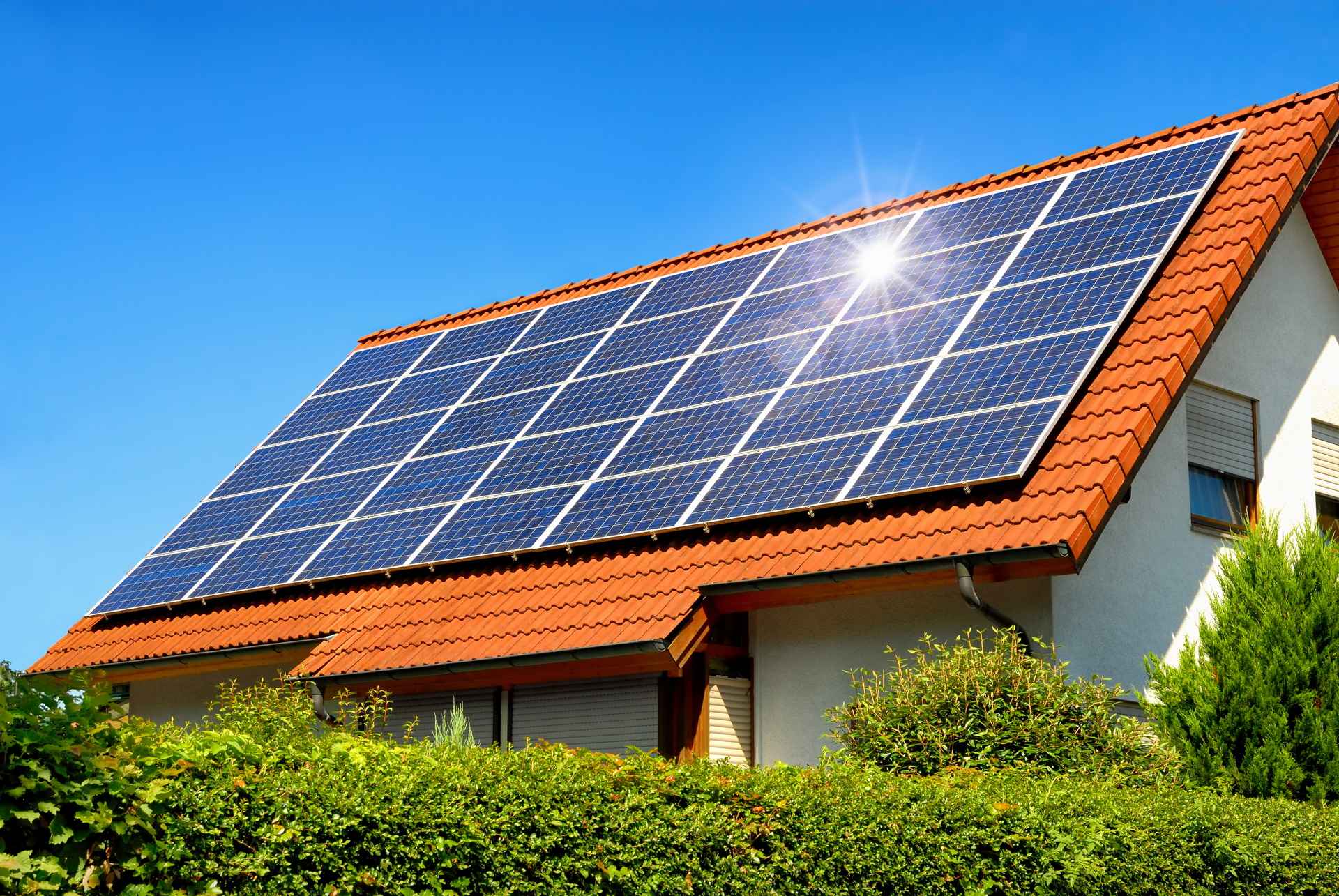Introduction
Solar energy, derived from the sun, is a clean and renewable source of power. Understanding how solar panels harness this energy can empower us to make informed decisions about sustainable living. In this guide, we’ll cover the basics of solar energy, the photovoltaic effect, and the role of solar panels in converting sunlight into electricity.
What Is Solar Energy?

The Sun as a Nuclear Fusion Powerhouse
At the heart of our solar system lies the sun—a colossal nuclear fusion reactor. Through the process of nuclear fusion, hydrogen atoms within the sun’s core combine to form helium atoms. This fusion releases an enormous amount of energy in the form of photons. These high-energy particles travel through space, reaching Earth and providing us with solar energy. Imagine the sun’s core as a seething cauldron of nuclear reactions, where temperatures soar to a blistering 27 million degrees Fahrenheit!
Photons and Their Role in Solar Energy Production
Photons are the fundamental units of light. When sunlight reaches Earth, it consists of countless photons. Solar panels, made primarily of silicon, harness these photons. Here’s how it works:
- Absorption: Solar panels absorb sunlight, allowing photons to interact with the silicon atoms.
- Electron Excitation: When a photon strikes a silicon atom, it excites an electron, causing it to move from its usual orbit.
- Electric Current: The movement of these excited electrons creates an electric current within the solar cell.
- Conversion to Electricity: This direct current (DC) electricity generated by solar panels can power our homes. Inverters convert it into alternating current (AC), which runs our lights, appliances, and gadgets.
The Photovoltaic Effect Explained
How Solar Panels Generate Electricity
Solar panels operate based on the photovoltaic effect, a phenomenon discovered by Edmond Becquerel in 1839. Here’s how it works:
- Absorption of Sunlight: Solar panels are made up of multiple solar cells, which contain layers of semiconducting material, typically silicon. When sunlight (composed of photons) strikes these cells, it transfers energy to the electrons within the silicon atoms.
- Electron Excitation: The absorbed energy excites the electrons, causing them to move from their usual orbits. This movement creates an electric current within the solar cell.
- Electricity Generation: The flow of excited electrons generates a direct current (DC) of electricity. Multiple solar cells are connected in series within a solar panel to produce a usable voltage. However, this DC electricity isn’t directly usable in our homes.
- Inverters: To make the electricity compatible with our appliances, inverters are used. They convert the DC electricity into alternating current (AC), which powers our lights, gadgets, and other devices.
Solar Panels: The Heart of the System
Composition and Structure of Solar Cells
Solar panels consist of multiple interconnected solar cells. These cells are the building blocks responsible for converting sunlight into electricity. Here’s how they work:
- Materials: Solar cells are primarily made of semiconducting material, with silicon being the most common choice. Silicon has unique properties that allow it to absorb sunlight effectively.
- Layers: Each solar cell contains two layers: the n-type (negatively charged) and the p-type (positively charged). These layers create an electric field within the cell.
- Electron Movement: When sunlight strikes the solar cell, it excites electrons in the silicon. These excited electrons move from the n-type layer to the p-type layer, creating an electric current.
Absorption of Sunlight and Electron Liberation
The process begins with the solar panel absorbing sunlight. Photons from the sun transfer energy to the electrons in the silicon atoms. As a result, electrons gain enough energy to break free from their atomic orbits. This liberation of electrons generates an electric current, which flows through the solar cell and contributes to the overall output of the solar panel.
In summary, solar panels are intricate systems composed of interconnected solar cells. Their ability to absorb sunlight and liberate electrons allows us to harness clean energy from the sun.
From Sunlight to Usable Electricity
Solar Energy: A Carbon-Free Power Source Solar energy is a form of renewable energy that harnesses sunlight to produce electricity, heat, or other usable forms of energy. Unlike fossil fuels, solar energy is “carbon-free,” meaning it doesn’t emit greenhouse gases that contribute to climate change. Here’s how it works:
Solar Photovoltaics (PV):
Most of today’s solar energy comes from solar photovoltaic (PV) systems. These systems rely on semiconductor materials, such as silicon, which can absorb sunlight and convert it into electric current. When sunlight hits a solar cell, it excites electrons within the semiconductor material, causing them to move freely. Metal conductors collect these electrons, creating an electric current that can power homes, electric vehicles, and other devices.
Efficiency Improvements:
Early solar panels, developed in the 1950s, were expensive and inefficient, converting less than 10% of sunlight into electricity. However, advances in engineering and cheaper PV chemistries have led to more efficient panels. Today, solar energy prices have dropped significantly, making it an attractive option for both large-scale solar farms and residential rooftops.
Scalability:
Solar PV systems are versatile. The same panels can work in massive solar farms or on individual rooftops. Homeowners looking to save on energy bills, remote hospitals in low-income countries, and communities seeking backup power during blackouts all benefit from solar energy’s scalability.
The Role of Inverters
Converting DC to AC Inverters plays a crucial role in solar energy systems. Here’s how they work:
Direct Current (DC):
Solar panels generate direct current (DC) electricity. However, most of our appliances and electrical devices run on alternating current (AC). To make solar energy usable in our homes, we need to convert DC to AC.
Inverters:
Inverters are electronic devices that perform this conversion. They take the DC electricity produced by solar panels and transform it into AC electricity compatible with our household appliances. Inverters ensure that the electricity flows in the right direction, maintaining a consistent voltage and frequency.
Types of Inverters:
- String Inverters: Commonly used in residential systems, string inverters connect multiple solar panels in series. They are cost-effective but may suffer from reduced efficiency if one panel is shaded or malfunctions.
- Microinverters: Each solar panel has its microinverter, allowing independent optimization. Microinverters are ideal for situations where shading or panel variations occur.
- Central Inverters: Used in large-scale solar farms, central inverters handle the entire array of panels. They are efficient but less flexible than microinverters.
Grid Connection:
Inverters also enable solar systems to feed excess electricity back into the grid. When your solar panels produce more energy than you need, the surplus flows into the grid, earning you credits or reducing your energy bill.
Feeding Clean Energy into Our Homes
Solar energy, harnessed through photovoltaic panels and supported by inverters, provides a sustainable and environmentally friendly way to power our homes. As solar technology continues to evolve, it promises a brighter, cleaner future for all of us.
Beyond Solar Panels: Other Solar Technologies
Solar Hot Water Systems:
- Solar hot water systems, also known as solar thermal systems, capture sunlight to heat water directly. Here’s how they work:
- Collectors: These systems have solar collectors (usually flat panels or evacuated tubes) installed on rooftops or other sunny areas. The collectors absorb sunlight and transfer the heat to a fluid (usually water or antifreeze).
- Heat Exchanger: The heated fluid circulates through a heat exchanger, transferring its warmth to the water in a storage tank.
- Domestic Use: Solar hot water systems provide hot water for showers, baths, and household needs. They are especially popular in sunny regions and can significantly reduce energy bills.
Concentrated Solar Power (CSP):
- CSP systems use mirrors or lenses to concentrate sunlight onto a receiver, which then converts the solar energy into electricity. Here’s how CSP works:
- Mirror Arrays: Large arrays of mirrors (heliostats) track the sun and reflect sunlight onto a central receiver.
- Receiver: The receiver absorbs the concentrated sunlight and heats a working fluid (such as molten salt or steam).
- Power Generation: The heated fluid drives a turbine connected to a generator, producing electricity.
- Storage: CSP systems can store excess heat, allowing them to generate power even when the sun isn’t shining.
- Applications: CSP is used in utility-scale power plants, providing clean energy to the grid.
Conclusion
Solar energy, with its remarkable ability to harness sunlight and convert it into usable electricity, holds immense promise for a sustainable future. Here are the key takeaways:
Clean and Renewable: Solar energy is a clean, renewable resource that doesn’t produce greenhouse gas emissions. By capturing sunlight, we reduce our reliance on fossil fuels and contribute to a healthier planet.
Solar Panels: Photovoltaic panels (solar panels) are the most common way to generate solar electricity. Advances in technology have made them more efficient and affordable, allowing homeowners and businesses to adopt solar power.
Inverters: Inverters play a vital role in converting direct current (DC) from solar panels into alternating current (AC) suitable for our homes. They ensure seamless integration with the grid and efficient energy use.
Beyond Panels: Solar hot water systems and concentrated solar power (CSP) are other exciting solar technologies. Solar hot water systems directly heat water using sunlight, while CSP uses mirrors to concentrate sunlight for large-scale electricity generation.
A Brighter Future: As research continues and technology evolves, solar energy will play an increasingly significant role in our energy mix. From rooftops to solar farms, every ray of sunlight contributes to a greener, cleaner world.
FAQ’s
What is solar energy?
Solar energy is the radiant light and heat from the Sun that can be harnessed using various technologies, primarily solar panels, to generate electricity or heat.
How do solar panels work?
Solar panels, or photovoltaic (PV) panels, convert sunlight into electricity. They contain cells made of semiconductor materials, typically silicon, which absorb sunlight and release electrons. This process generates a flow of electricity.
How much sunlight do solar panels need to be effective?
Solar panels are most effective in direct sunlight, but they can still generate electricity on cloudy days and in indirect sunlight. The efficiency varies depending on the quality of the panels and the amount of sunlight available.
Can solar energy be stored?
Yes, solar energy can be stored in batteries. This allows for the use of solar power during times when the sun is not shining, such as at night or during cloudy weather.












